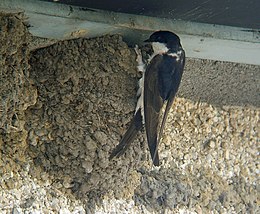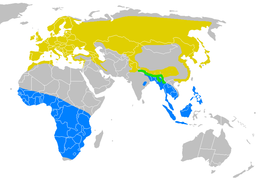
Back ديليشون ARZ Edgabia (Delichon) AVK Şəhər qaranquşu Azerbaijani Delichon Breton Delichon Catalan Delichon CEB Чĕкеç CV Delichon German Delichon Esperanto Delichon Spanish
| Delichon | |
|---|---|

| |
| Common house martin (Delichon urbicum) | |
| Scientific classification | |
| Domain: | Eukaryota |
| Kingdom: | Animalia |
| Phylum: | Chordata |
| Class: | Aves |
| Order: | Passeriformes |
| Family: | Hirundinidae |
| Subfamily: | Hirundininae |
| Genus: | Delichon F. Moore, 1854 |
| Type species | |
| Delichon nipalense F. Moore, 1854
| |
| Species | |
|
4, see below. | |

| |
| |
Delichon is a small genus of passerine birds that belongs to the swallow family and contains four species called house martins. These are chunky, bull-headed and short-tailed birds, blackish-blue above with a contrasting white rump, and with white or grey underparts. They have feathering on the toes and tarsi that is characteristic of this genus. The house martins are closely related to other swallows that build mud nests, particularly the Hirundo barn swallows. They breed only in Europe, Asia and the mountains of North Africa. Three species, the common, Siberian and Asian house martins, migrate south in winter, while the Nepal house martin is resident in the Himalayas year-round.
The house martins nest in colonies on cliffs or buildings, constructing feather- or grass-lined mud nests. The typical clutch is two or three white eggs; both parents build the nest, incubate the eggs and feed the chicks. These martins are aerial hunters of small insects such as flies and aphids. Despite their flying skills the Delichon martins are sometimes caught by fast-flying birds of prey. They may carry fleas or internal parasites. None of the species are considered threatened, although widespread reductions in common house martin numbers have been reported from central and northern Europe. This decline is due to factors including poor weather, poisoning by agricultural pesticides, lack of mud for nest building and competition with house sparrows for nest sites.